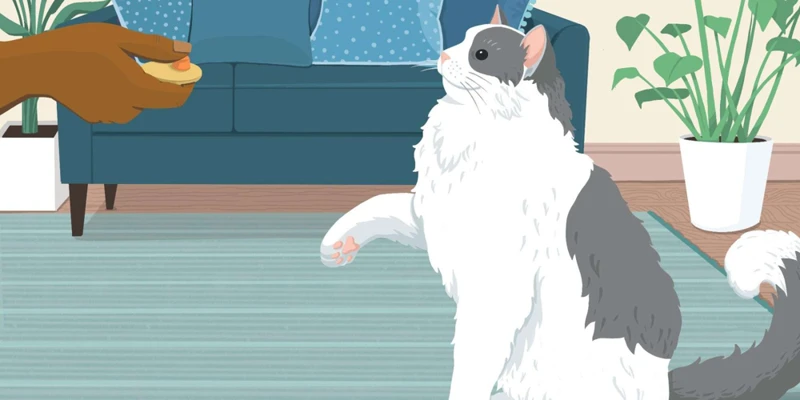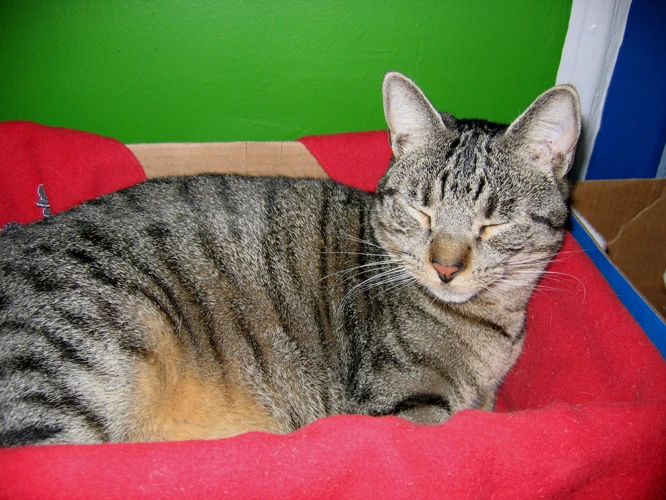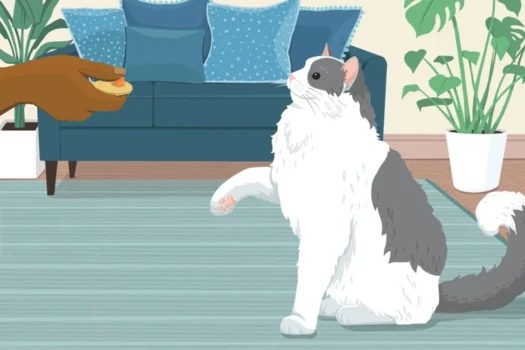Introduction: What is Clicker Training?

Clicker training is a positive reinforcement training method that uses a small clicker device to mark desired behaviors and reward them with treats or praise. It is a popular training technique used by many animal trainers and owners, including those with California Spangled Cats.
In clicker training, the clicker sound is used to communicate to the cat that they have performed a desirable behavior, and a reward follows immediately. This helps the cat associate the behavior with a positive outcome and learn to repeat the behavior in the future. Clicker training is based on behavioral psychology research that shows positive reinforcement is more effective in changing behavior than punishment-based techniques.
Clicker training is an especially effective training technique for cats because it allows for clear communication between the owner and the cat, reducing misunderstandings and frustration. Additionally, clicker training helps to build a stronger bond between the owner and the cat.
In the following sections, we will discuss the science behind clicker training and how it affects the brain, as well as its benefits, how to get started with clicker training, and tips for successful clicker training with your California Spangled Cat. If you want to know more about the benefits of clicker training for California Spangled Cats, click here.
The Science Behind Clicker Training for Cats

Clicker training is a popular and effective method of training cats that is based on positive reinforcement. It involves using a device that emits a distinct clicking sound to signal to the cat that they have performed the desired behavior and will receive a reward. However, there is more to clicker training than simply rewarding good behavior. Understanding the science behind clicker training is key to its success. By understanding how this training method affects the brain, and why it is more effective than traditional methods, you can train your California Spangled cat more effectively and with less stress. Let’s explore the science behind this fascinating training method.
How Clicker Training Affects the Brain
Clicker training affects the brain in several ways, which explains why it is such an effective training method for California Spangled cats. When a cat performs a desired behavior and hears the sound of the clicker, it triggers the release of dopamine in the brain. This chemical is a neurotransmitter that is often associated with pleasure and rewards, and it creates a positive association in the cat’s mind between the behavior and the reward.
This positive reinforcement encourages the cat to repeat the behavior in the future, as it associates the behavior with a positive outcome. Clicker training helps to establish new neural pathways in the brain, which can lead to permanent changes in behavior.
Another important aspect of clicker training is that it can help to reduce stress and anxiety in cats. Training through force or punishment can cause a cat to develop a negative association with their owner or the training activity itself, but clicker training is a non-threatening and enjoyable process. This can help to create a stronger bond between owner and cat, and to reduce stress and anxiety in the cat.
Clicker training is a scientifically proven training method that is effective for California Spangled cats. By creating positive associations in the cat’s brain, it can help to establish new behaviors, reduce stress and anxiety, and create a stronger bond between owner and cat. For more information on clicker training for cats, check out our cat clicker training guide.
Positive Reinforcement and Behavior Modification
Positive reinforcement is a key aspect of clicker training for cats, and it involves rewarding good behavior with treats, attention, or praise. This technique is based on the belief that cats will repeat behaviors that result in positive outcomes, while avoiding behaviors that lead to negative consequences. By using positive reinforcement, we encourage our cats to understand that certain actions are desirable and will be rewarded, while negative actions will not be.
In addition to encouraging desirable behavior, clicker training can also be a powerful tool for behavior modification. For example, if a California Spangled cat is exhibiting unwanted behavior such as scratching furniture, positive reinforcement can be used to redirect their behavior towards a more appropriate alternative such as a scratching post.
Rather than punishing the cat for the undesirable action, which may cause fear or stress, clicker training associates positive outcomes with appropriate actions. This creates a positive experience for the cat and encourages them to repeat the desired behavior. This is in stark contrast to traditional training methods, which often involve punishment for negative behavior rather than reinforcing positive behavior.
Positive reinforcement as a behavior modification technique is highly effective, especially when used in conjunction with clicker training. By reinforcing good behavior and redirecting undesirable behavior, we are able to create a positive environment for our cats and foster a strong, healthy bond between owner and cat. For additional tips and tricks on clicker training for California Spangled cats, check out our clicker training tips.
Why Clicker Training is More Effective Than Traditional Training Methods
Clicker training has been proven to be a more effective training method than traditional training methods. The use of a clicker to pinpoint and reinforce specific behaviors allows for a clearer communication between the owner and the cat. Traditional training methods, on the other hand, rely on punishment and correction, which can cause fear and anxiety in cats, leading to an ineffective and even counterproductive training experience.
The following table highlights the key differences between clicker training and traditional training methods for California Spangled Cats:
| Clicker Training | Traditional Training Methods |
|---|---|
| Uses positive reinforcement to encourage desired behaviors | Relies on punishment and correction to discourage undesired behaviors |
| Clear communication between owner and cat | May lead to fear and anxiety in cats |
| Focuses on rewarding good behavior rather than punishing bad behavior | Focuses on correcting bad behavior rather than rewarding good behavior |
| Encourages cats to learn and think for themselves | May lead to a cat being trained to simply follow orders |
| Strengthens the bond between owner and cat through positive interactions | May strain the relationship between owner and cat through negative interactions |
While traditional training methods may seem like the most common and straightforward approach, they can be detrimental to the cat’s well-being and your relationship with them. Clicker training provides a more effective and humane approach to training, and it is the recommended method for training California Spangled Cats. To learn more about clicker training for your California Spangled Cat, check out this article on our website.
Benefits of Clicker Training for California Spangled Cats

As a cat owner, you want your feline companion to be happy and healthy. One way to achieve this is through clicker training. Clicker training for California Spangled cats has numerous benefits both for the cat and for you as the owner. By understanding the advantages of this training method, you can make an informed decision about whether or not to incorporate it into your cat’s routine. Let’s take a look at some of the benefits of clicker training for California Spangled cats.
If you’re interested in avoiding mistakes in clicker training your California Spangled Cat, check out our article about common mistakes owners make in clicker training California Spangled cats.
Improved Learning and Comprehension
Clicker training has been found to improve learning and comprehension in cats, including California Spangled cats. This training method is based on positive reinforcement, which means that a cat is rewarded for good behavior and ignores bad behavior. The use of a clicker helps the cat to make a connection between the behavior and the reward.
Research has shown that clicker training can help cats learn faster and retain information for longer periods of time than other forms of training. One study found that cats trained with clickers were more likely to remember specific actions and tricks six weeks after the training sessions ended than those trained with voice commands alone.
Clicker training for California Spangled cats also helps them to develop a better understanding of the desired behavior. The cat learns to associate the sound of the clicker with a treat, so it begins to understand that certain behaviors are rewarded and others are not. This helps the cat to understand commands and tricks more easily, which makes training more effective and enjoyable for both the cat and the owner.
Using clicker training to improve learning and comprehension in California Spangled cats requires patience and consistency. It is important to start with simple and achievable goals, such as teaching the cat to come when called or to sit on command. As the cat becomes more comfortable with the clicker training, more complex commands and tricks can be added.
Clicker training is a highly effective method for improving learning and comprehension in California Spangled cats. It encourages positive behaviors and helps cats to develop a strong understanding of the desired behavior. By using clicker training, owners can help their cats to learn new tricks and behaviors while building a closer bond with their beloved pet.
| Benefits of Improved Learning and Comprehension with Clicker Training | Examples |
|---|---|
| Increased ability to learn and remember commands | A California Spangled cat can learn to come when called or sit on command |
| Improved comprehension of expected behaviors | A California Spangled cat can learn the difference between good and bad behavior and respond accordingly |
| Enhanced communication between cat and owner | A California Spangled cat can learn to respond to different verbal commands and gestures |
| Increased enjoyment of training sessions | A California Spangled cat can learn new tricks and behaviors in a fun and engaging way |
To learn more about the benefits of clicker training for California Spangled cats, check out Advanced Clicker Training for California Spangled Cats. If you’re interested in comparing clicker training to traditional training methods, read our guide on Clicker Training vs. Traditional Training for California Spangled Cats. And if you’re dealing with a California Spangled cat that has fear or anxiety issues, find out how clicker training can help in our article on Training a California Spangled Cat with Fear or Anxiety Using Clicker Training.
Reduced Stress and Anxiety
Reduced Stress and Anxiety
One of the key benefits of clicker training for California Spangled cats is the reduced stress and anxiety it can bring. Traditional training methods often rely on punishment and negative reinforcement, which can cause stress and anxiety in cats. Clicker training, on the other hand, uses positive reinforcement to encourage and reward good behavior.
How Clicker Training Reduces Stress and Anxiety?
Clicker training focuses on teaching cats what to do, rather than punishing them for what they shouldn’t do. This approach can help California Spangled cats feel more confident and less anxious about training sessions.
In addition to the training itself, the use of a clicker as a consistent marker can also help reduce stress and anxiety. The cat learns that the sound of the clicker means something positive is about to happen, and therefore associates the sound with reward. This can create a more positive and relaxed training environment for both the cat and their owner.
The Importance of Avoiding Punishment-based Techniques
Not only does punishment-based training increase stress in California Spangled cats, but it can also lead to other behavior problems. Cats that are punished for undesirable behavior may become fearful and anxious, which can make them more aggressive or cause them to engage in unwanted behaviors, such as spraying or scratching.
Punishment-based techniques can damage the bond between a cat and their owner. Instead of building trust and positive associations, punishment creates a negative association with the owner and can lead to a breakdown in communication and trust.
Summary
Clicker training is a more effective and humane way to train California Spangled cats. By using positive reinforcement and focusing on teaching desirable behaviors, this training method can reduce stress and anxiety and enhance the bond between cat and owner. It is important to avoid punishment-based techniques and instead focus on creating a positive and relaxed training environment for your cat.
| Key Points: |
|---|
| Clicker training uses positive reinforcement to encourage good behavior in California Spangled cats. |
| Punishment-based techniques can increase stress and anxiety and lead to behavior problems. |
| Clicker training creates a positive association with the owner and can enhance the bond between cat and owner. |
Enhanced Bond between Owner and Cat
One of the most significant benefits of clicker training for California Spangled Cats is that it can enhance the bond between the owner and the cat. By spending quality time together during training sessions, the owner and the cat can strengthen their relationship in a positive way.
How Clicker Training Can Improve the Bond Between Owner and Cat
Clicker training involves positive reinforcement, which means that the cat will be rewarded for good behavior. Providing rewards like treats, praise, and petting can help to associate the owner with pleasant experiences, and the cat will be more likely to repeat the good behavior in the future.
Clicker training can be an enjoyable experience for both the cat and the owner. By engaging in fun activities together, the owner and the cat can build a positive association with each other and strengthen their bond. This increased interaction and communication can also lead to the owner better understanding their cat’s behavior and personality, which can ultimately lead to better care for the cat.
Ways to Enhance the Bond Through Clicker Training
To further enhance the bond between the owner and the California Spangled Cat during clicker training sessions, consider the following tips:
| Tips | Description |
|---|---|
| Make it a Regular Occurrence | Try to schedule a clicker training session at the same time each day or week so that the cat knows when to expect it. This can help build anticipation and excitement for the cat. |
| Be Patient and Encouraging | Clicker training requires patience and consistency. Be sure to encourage and praise your cat’s progress, even if it is slow. This can help build your cat’s confidence and trust in you as the owner. |
| Be Creative with Clicker Training Exercises | Consider introducing new exercises and tricks to keep the training sessions fun and engaging for you and your cat. This can also help prevent boredom and frustration. |
| Use Positive Reinforcement Beyond Training Sessions | Try to incorporate positive reinforcement techniques into everyday life with your cat. This can include providing treats or praise when your cat exhibits good behavior. |
With consistent and positive clicker training, not only can the California Spangled Cat learn new behaviors, but it can also build a more meaningful bond with its owner. This strengthened relationship can lead to better communication, trust, and understanding between cat and owner, facilitating a more fulfilling relationship for both parties.
Preventing Undesirable Behaviors and Correcting Existing Ones
As a cat owner, dealing with undesirable behaviors from your feline friend can be frustrating and exhausting. However, clicker training can be an effective way to prevent these behaviors or to correct existing ones. Here are some examples of how it can be used:
| Undesirable Behavior | Clicker Training Solution |
|---|---|
| Scratching furniture or other household items | Train your cat to use a scratching post by clicking and treating whenever they use it. Encourage use of the post by placing it in a prominent location and sprinkling catnip on it. |
| Biting or scratching during playtime | Use clicker training to teach your cat appropriate play behavior, such as chasing and pouncing on toys instead of human limbs. Reinforce positive play behavior with plenty of treats and praise. |
| Messing outside the litter box | Clicker train your cat to use the litter box consistently by rewarding them with a treat and praise every time they use it. Place multiple litter boxes around the house in case your cat has trouble accessing one of them. |
It’s important to remember that correcting existing undesirable behaviors with clicker training requires patience and consistency. With persistence, however, you can effectively transform negative behaviors into positive ones.
Getting Started with Clicker Training for Your California Spangled Cat

If you’re ready to start clicker training your California Spangled cat, there are a few things you need to know before getting started. The process involves more than just pressing a button and giving treats. In this section, we’ll cover everything you need to know to successfully begin clicker training your feline companion, including choosing the right clicker, identifying positive reinforcers, setting achievable goals, and being consistent and patient throughout the process. Let’s dive in!
Choosing the Right Clicker
One of the most important aspects of clicker training is choosing the right clicker. Not all clickers are created equal, and it’s important to find one that is comfortable for you to use and produces a consistent sound that your cat can easily distinguish. Here are some factors to consider when choosing the right clicker:
| Factor | Consideration |
|---|---|
| Sound | Choose a clicker that produces a clear and consistent sound that your cat can easily distinguish. Some clickers can be too loud or too soft, so it’s important to test out different options and find one that works best for you and your cat. |
| Size and Shape | Clickers come in a variety of sizes and shapes, so it’s important to find one that is comfortable for you to use. Some clickers are small and can be easily held in your hand, while others are larger and may have a strap or clip for attaching to your clothing. |
| Material | Clickers can be made from a variety of materials, including plastic, metal, and even wood. Consider the durability and longevity of the clicker, as well as whether it can be easily sanitized or cleaned. |
| Type | There are two main types of clickers: button clickers and box clickers. Button clickers require the user to press a button to make the clicking sound, while box clickers produce a clicking sound when the box is pressed. Both types can be effective, so choose the one that feels most comfortable for you to use. |
Choosing the right clicker is an important step in effectively clicker training your California Spangled Cat. By considering factors like sound, size and shape, material, and type of clicker, you can find one that fits your preferences and helps your cat to learn and respond to positive reinforcement.
Identifying Treats and Positive Reinforcers
When it comes to clicker training, positive reinforcement is essential. This means that you’ll need to identify treats and other rewards that your California Spangled cat likes receiving. These treats will serve as positive reinforcement for good behavior, which will encourage your cat to continue performing the desired action.
Identifying the right treats for your cat is crucial. Some cats may prefer a certain type of treat or food over others. Pay attention to what your cat gets excited about during meal times or when you’re rewarding them. Common cat treats and rewards include tuna, chicken, fish, cheese, and catnip.
Once you have identified the treats that your cat likes, it’s time to start using them as positive reinforcement. Every time your cat performs a desired behavior, reward them with a treat or a quick play session. This will help reinforce the behavior and make it more likely that your cat will repeat it in the future.
To make the rewards more effective, it’s recommended to use small treats that your cat can easily consume. Additionally, make sure to vary the treats from time to time to keep things interesting for your cat.
It’s important to keep in mind that clicker training isn’t just about treats. While food rewards may be the most effective, other positive reinforcements such as play or petting can also be used to encourage good behavior. Ultimately, the key is to find what works best for your cat and use it consistently.
Here’s a table of common treats and positive reinforcements for clicker training your California Spangled cat:
| Treats | Positive Reinforcements |
|---|---|
| Tuna | Playtime |
| Chicken | Petting |
| Fish | Laser pointer play |
| Cheese | Verbal praise |
| Catnip | Cuddling |
By effectively using treats and other positive reinforcements, you’ll be able to encourage your California Spangled cat to learn new behaviors and improve their overall behavior. Remember, consistency is key when it comes to clicker training, so be sure to reward your cat every time they exhibit the desired behavior.
Setting Achievable Goals for Your Cat
One of the most important aspects of clicker training for California Spangled cats is setting achievable goals. Clicker training involves breaking down complex behaviors into smaller, more manageable steps to help your cat learn new behaviors and skills. By setting achievable goals, you can avoid overwhelming your cat and ensure that each training session is progress towards a larger goal.
Here are some tips for setting achievable goals for your cat:
- Start with simple behaviors: When first starting out with clicker training, it’s important to begin with behaviors that are easy for your cat to learn. Simple behaviors like sitting or coming when called are good places to start. Once your cat has mastered these basic behaviors, you can move on to more complex behaviors.
- Break down larger behaviors into small steps: For more complex behaviors, it’s important to break them down into smaller, more manageable steps. For example, if you want to train your cat to jump through a hoop, you can break the behavior down into smaller steps such as touching the hoop with their nose, stepping into the hoop, and finally jumping through the hoop.
- Be realistic: It’s important to set goals that are realistic and achievable for your cat. Keep in mind their age, breed, and skill level when setting goals. Setting unrealistic goals can lead to frustration for both you and your cat, and can hinder progress in the long run.
- Track progress: Keep track of your cat’s progress and celebrate their successes along the way. This can help keep both you and your cat motivated and engaged in the training process.
- Adjust goals as needed: Finally, be willing to adjust your goals as needed based on your cat’s progress and comfort level. If your cat is struggling with a particular behavior, it may be necessary to break the behavior down into smaller steps or adjust your approach to training.
By setting achievable goals for your California Spangled cat, you can help ensure that training sessions are enjoyable, effective, and stress-free for both you and your furry companion.
Consistency and Patience
Consistency and patience are both key components of successful clicker training for California Spangled Cats. Your cat will not learn overnight, and it is essential to provide consistent training sessions to reinforce the desired behaviors gradually. Here are some tips to help promote consistency and patience in your clicker training practices:
- Stick to a routine: Plan regular training sessions at a time when your cat is most alert and willing to learn. Consistency in your training routine will help your cat understand what is expected of them during these designated times.
- Practice makes perfect: Always aim for progressing gradually with your cat’s training. Don’t rush and expect your Spangled cat to pick up on the training cues quickly. Be patient and repeat the training cues in short sessions daily to help your cat grasp what is expected of them.
- Positive reinforcement: Consistent use of positive reinforcement will help to encourage your cat to perform the desired behaviors again and again. Rewarding your cat with treats or pets after they followed a command will help to reinforce their positive behavior, leading to quicker and improved learning.
- Learn from mistakes: Clicker training may not always go according to plan. Don’t become disheartened if your cat does not perform as expected on the first few attempts. Instead, observe where you went wrong, adjust your approach, and try again. With patience and consistency, your cat will eventually learn the desired behavior.
- Stay calm: It’s easy to become frustrated when things don’t go as planned, but it is essential to stay calm and composed during clicker training. A calm and relaxed environment will encourage your cat to feel safe, which helps to reduce their stress and anxiety.
While consistency and patience may seem like small factors in clicker training, they play a significant role in achieving the desired behaviors for California Spangled Cats. Remember to be consistent, patient, and always reinforce positive behaviors while remaining calm and focused. With perseverance and dedication, your Spangled cat will become a well-trained, happy companion.
Tips for Successful Clicker Training for California Spangled Cats
As with any training method, clicker training for California Spangled Cats requires time, patience, and a bit of trial and error. To help ensure your training sessions are successful, we’ve compiled some useful tips and tricks to keep in mind. By using these tips, you’ll be on your way to a stronger bond with your feline companion and a well-behaved California spangled cat. Let’s dive in!
Keep Sessions Short and Sweet
During clicker training sessions for your California Spangled cat, it is important to keep them short and sweet to prevent overwhelming your cat and maintain their interest and focus. Cats have a short attention span, so keeping sessions brief will help them to retain what they have learned and make progress over time.
Tips for Keeping Sessions Short and Sweet
To help make the most of each training session, consider implementing the following tips:
| Tip | Explanation |
|---|---|
| Limit session time | Sessions should last no more than 10-15 minutes to avoid overwhelming your cat. Consider breaking training up into several short sessions throughout the day. |
| Prevent Distractions | Ensure that your training environment is quiet and free of distractions so that your cat can focus on the task at hand. |
| Keep it fun and engaging | Include a variety of tasks and activities during each training session to keep your cat interested and motivated. |
| Monitor your cat’s interest level | Pay attention to your cat’s body language and behavior. If they seem disinterested or distracted, it may be time to end the session. |
By adhering to these tips, you can ensure that your California Spangled cat enjoys and benefits from each clicker training session. Remember to always end each session on a positive note by rewarding your cat with a treat or praise for their hard work and progress. With consistency and patience, your cat will quickly learn new behaviors and skills through clicker training.
End Each Session on a Positive Note
When clicker training your California Spangled cat, it’s important to end each session on a positive note. This helps your cat to associate the training with positive experiences, which will encourage them to look forward to future sessions. Here are some tips for ending each session on a high note:
| Tip | Description |
| 1 | End on a successful note: Always try to end the session after your cat has successfully completed a desired behavior. This reinforces their positive behavior and ensures they end on a good note. |
| 2 | Give verbal praise: In addition to clicking the clicker, give verbal praise to your cat. Use a warm and encouraging tone when talking to your cat. This reinforces positive behavior and signals to your cat that they have done something right. |
| 3 | Reward your cat: Reward your cat with a treat or toy after they have completed a training session. This will reinforce positive behavior and ensure they continue to look forward to future training sessions. |
| 4 | End the session before your cat gets bored: Keep your cat engaged and interested throughout the session, but end the session before they get bored or lose focus. This makes sure they stay enthusiastic about future training sessions. |
By following these tips, you can ensure that each clicker training session is a positive experience for your California Spangled cat. This will help you build a stronger bond with your pet and make training more effective.
Use Clicker Training to Build a Stronger Relationship with Your Cat
One of the biggest benefits of clicker training for California Spangled cats is the strengthened bond between you and your furry friend. By using positive reinforcement, you can create a positive association between your cat and the training process. This, in turn, can strengthen your relationship with your cat.
Here are some ways that clicker training can help build a stronger relationship with your California Spangled cat:
- Increased Trust: Because clicker training relies on positive reinforcement, your cat learns to trust you and the training process. As your cat becomes more comfortable with the training, they will begin to trust you more and rely on you for guidance.
- Improved Communication: By using a clicker, you can communicate with your cat in a way that they understand. They quickly learn that the clicking sound means they have done something right and a reward is on the way. This creates clear lines of communication between you and your pet.
- Greater Understanding: Through clicker training, you can gain a greater understanding of your cat’s behavior and personality. You may notice that your cat responds better to certain types of treats or rewards, or that they learn best through short training sessions. This insight can strengthen your bond and help you understand your pet on a deeper level.
- Fewer Behavioral Issues: By preventing and correcting undesirable behaviors through clicker training, you can create a more harmonious household. Your cat will learn what is expected of them and what behaviors will be rewarded, which can lead to a stress-free and happy home.
Clicker training is a great way to bond with your California Spangled cat while helping them learn new behaviors and skills. By incorporating positive reinforcement and regular training sessions into your routine, you can build a stronger, more trusting relationship with your feline friend.
Conclusion: Why Clicker Training is the Best Way to Train Your California Spangled Cat
Clicker training is undoubtedly one of the best ways to train your California Spangled cat. It is an effective and humane method that is based on the principles of positive reinforcement. By using a clicker to mark desirable behavior and offering rewards, you can teach your cat new skills and modify undesirable behaviors in a way that is gentle, fun, and stress-free.
With clicker training, you can help your cat learn and understand more quickly and effectively. This is because clicker training is based on the science of how the brain works, and it encourages your cat to think, problem-solve, and learn on a deeper level. Additionally, clicker training allows you to build a stronger bond with your cat since it requires patience, consistency, and communication in a way that other training methods do not.
Compared to traditional training methods, clicker training is also more effective. Traditional training methods such as punishment and negative reinforcement can actually cause your cat more stress and anxiety, leading to a breakdown in communication and even behavioral problems. With clicker training, you can avoid all of this and instead offer your cat a positive and enjoyable learning experience that is tailored to their individual needs and personality.
Finally, clicker training offers a range of benefits for both you and your California Spangled cat, including improved learning and comprehension, reduced stress and anxiety, enhanced bonding, and the prevention and correction of undesirable behaviors. If you want to get started with clicker training your cat, be sure to choose the right clicker, identify the best treats and positive reinforcements, and set achievable goals for your cat. Remember to be patient, consistent, and enjoy the process of building a stronger relationship with your feline friend.
Frequently Asked Questions
What is the best age to start clicker training with my California Spangled Cat?
It is recommended to start clicker training when your cat is still a kitten, ideally between 8-12 weeks old. However, adult cats can also be trained through clicker training.
Is clicker training safe for cats?
Yes, clicker training is a safe and humane way to train your California Spangled Cat. It relies on positive reinforcement rather than punishment or force, making it less stressful for your cat.
Can clicker training be used to correct bad behavior in cats?
Yes, clicker training can be used to correct bad behavior in cats. By using positive reinforcement, you can replace undesirable behaviors with desirable ones.
What kind of treats can I use during clicker training?
You can use a variety of treats for clicker training, such as small pieces of cooked chicken, tuna, or commercial cat treats. Make sure the treats are small and easy to swallow, so your cat doesn’t get distracted during training.
How long should a clicker training session last?
Clicker training sessions should be kept short, ideally between 5-10 minutes. This allows your cat to stay focused and engaged, and prevents them from getting bored or frustrated.
What if my cat doesn’t respond to the clicker?
If your cat doesn’t respond to the clicker, it may be because they haven’t been conditioned to associate the sound with a reward yet. Try holding a treat in your hand and clicking the clicker at the same time, and then give your cat the treat immediately. Repeat this several times until your cat starts to associate the sound with the treat.
Is it possible to use clicker training to teach my cat tricks?
Yes, clicker training can be used to teach your California Spangled Cat a variety of tricks, such as jumping through a hoop, sitting, or rolling over. The key is to break the trick down into small, achievable steps, and reward your cat for each step they complete successfully.
How many times a day should I clicker train my cat?
It is recommended to clicker train your cat once or twice a day, depending on how quickly they are learning and progressing. Remember to keep sessions short and focused, and end each session on a positive note.
Can clicker training help with my cat’s anxiety?
Clicker training can help reduce anxiety in cats by providing a positive outlet for their energy and stimulating their mind. It can also strengthen the bond between you and your cat, which can help reduce anxiety and stress.
Do I need any special equipment to clicker train my cat?
You don’t need any special equipment to clicker train your California Spangled Cat. All you need is a clicker, some treats, and patience. However, you may want to invest in a target stick or a training mat to make training sessions more fun and interactive for your cat.







